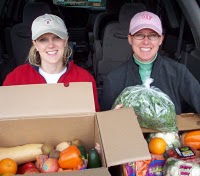By Angela Smith and Amy Memory
We all know buying fruits and veggies can be very expensive, especially when you try to buy organic foods. In order for us to save, we joined a food co-op. Although this is not a true co-op in the sense that we’re not partnering with local farmers, we’re helping each other save money by purchasing in bulk. We get tons of great food twice a month. We thought other moms might be interested, so here’s how our co-op operates:
Our co-op group includes 10-12 families who participate. We take turns ordering from a local produce shop and place the order for the group (a maximum of $35 per family is what we aim for). Orders can be placed either by email on the Thursday prior to pick-up or we try to arrive early on Saturday morning (6:15AM) and order from the list on site. If we email the order, we can arrive around 6:30 to pick up our order. The $35/box gives us about $420 (including taxes) to order from a list of available items which are categorized by types of fruits, vegetables, and even eggs, tofu, and salad dressings.
Some of the great organic and non-organic items we purchase this way include avocados, cucumbers, potatoes, sweet potatoes, tomatoes, squash (winter squashes as well as yellow squash in the summer), pineapples, grapes, kiwis, oranges, apples, pears, leaf lettuce, swiss chard, potatoes, cilantro, onions, baby-cut carrots, broccoli, cauliflower, okra, spinach, mixed greens, mushrooms, and mixed bell peppers. Our process is basically cutting out the middle-man, i.e. the grocery stores that order from Vernon’s.
After picking up the order, the designated family members go back to someone’s house and divide everything into the number of boxes for those families who are participating that week. We actually use laundry baskets with our names on them to keep it easy and we’re responsible for dropping off our baskets to the pick-up person’s house prior to Friday night. Most items are easy to divide by 12 (our typical number participating). Other items are a little more difficult. For example, the grapes come in 8 (2 lb) bags so you have to divide the grapes out as evenly as possible, or else order 3 total orders to get 24 bunches so each house gets 2 bunches.
It may sound confusing, but in the end, it saves us all a lot of time and money. There are some pros and cons, however, and they include:
Pros:
-Cost savings: We’ve calculated approximately a 40% to 60% savings over shopping for same items at regular grocery stores—even when the items are on sale at grocery store.
-Helps with meal planning.
-Makes you meal plan so that you don’t waste things.
-Exposes you to new things you might not otherwise buy or eat.
Cons:
-Allowing others to do your shopping and spend your money can be difficult.
-Shopping for others (when it’s your turn) can be a bit stressful.
-May get things you don’t like or don’t know how to cook.
-May have things go to waste (but it’s such a savings, we often give things away to family members or friends that aren’t in the co-op and don’t feel like we’re losing money).
In today’s economy, something like this can go a long way. Let us know if you participate in similar food co-ops and tell us how yours work!”
* Be sure to enter our newest giveaway here!
















